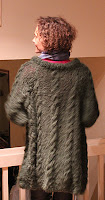 |
| Heart pendant by Rezie |
 |
| Brooch by Rezie |
I am a lucky recipient of my mom's beautiful pieces. Most recently she made a modern heart pendant and brooch.
 |
| Vest by Rezie |
 |
| Purse by Rezie |
Our parents' creativity has rubbed off on my sister and I. Before my sister moved to Turkey, and now Canada, she took the same jewelry-making classes with my mom and made stunning pieces. She's getting ready to resume her silversmithing soon in Vancouver.
My mom taught me the basics of knitting when I was a girl. In highschool it was a cool thing to do. I remember my three girlfriends and I knitting during Dutch literature classes, with the (male) teacher's approval though subject to much teasing from the boys.
In university I did some basic sewing, using a fabulous forest green soft velvet. The outfit included a long sweater with a big wide collar and long cuffs, a mini-skirt and a loose-fitting legging. It was simple, easy. I didn't follow a pattern. The result got plenty of wear, often mixed with a vintage jacket that I think belonged to my dad at one point, a beige lace blouse and scarfs, combined with dark brown suede high-heeled boots. I love earthy tones.
(This reminds me too of how in high school the pants of men's silk pyjamas were highly fashionable, as were men's shirts. I remember how I was getting ready for a party and had my heart set on wearing a short-sleeve striped shirt of my dad, and my growing panic when I couldn't find it anywhere. Running late, my dad came home from working wearing - you guessed it - that shirt. I wore it to the party, too.)
Among my family I am not known for being patient or skilled in working with my hands. I always thought that indeed patience was not among my traits but running has helped me discover I have plenty of it. I just need to start off at a level that isn't too advanced and work on projects that suit my temperament and disposition.
For some reason, I felt like knitting when we moved to Canada four years ago. Perhaps it was the revival of the craft. The cold winters, compared with those in Australia where we had spent the previous seven years, no doubt also helped that motivation. But I had completely forgotten how to steken opzetten, i.e. cast on, and asked my mom for help.
She sent me a booklet on how to do it but it wasn't until my parents came to visit Squamish for the first time three years ago that I made a start. My mom and I both got some wool, and got knitting as my mom re-taught me how to get started. The other basics - knitting, purling, cast off, and slipping - my hands remembered.
I used a super bulky wool, a wine-red Red Heart Light & Lofty , that called for big needles (10, or a US 15), which means it doesn't take long to make progress. The simple stocking stitch is a very easy and relaxing way to knit row after row. In that regard knitting reminds me of running; the soothing rhythm of both activities are very relaxing, meditative. There's a simple focus, too, step after step, and stitch after stitch.
Since we were doing plenty of sightseeing with my parents, I didn't finish the pieces of my sweater (no pattern of course) until after my parents left.
 |
| Sweater on 2nd try |
Incidentally, the pendant I am wearing with this sweater my mom made as well. She created a beautiful silver setting for this oval piece of agate. As I said, her productivity is amazing.
The arms are a little long, but other than that, it works. The yarn (100% acrylic) is soft, beautiful and warm. And did I mention it takes no time at all to do this? Next I used the same yarn to knit blankets - also plain stocking stitches - for my grandmother (blue sand) and one for Tim's mom (a gorgeous green called pine).
 |
| Sweater in progress |
Now I need to do my least favourite part, which is sewing the parts together. My mom suggested I knit the collar with four needles on the finished product so that there's no seam. I have no idea how that works but am keen to learn.
Meantime, she showed me how to do cables (there are a million variations of those) and encouraged me to do something a little more advanced. She took me to the attic to find a pattern and to see if there was any leftover yarn I could use for a project. We found a pattern for a very cute short bolero jacket and beige wool with history.
 |
| Bolero jacket in progress |
The bolero jacket is knitted in one piece, so there's a lot of increasing and decreasing of stitches, as well as casting off parts while you keep going with the remainder. But it's a plain stocking stitch. As mom helped me figure out how to get started yesterday afternoon, I made it halfway last night. So far so good!
